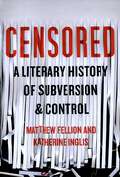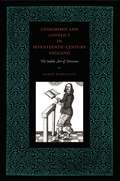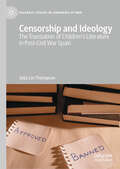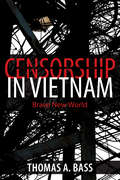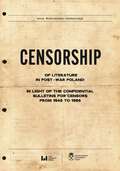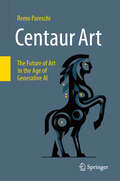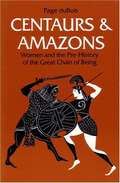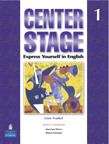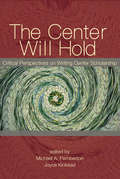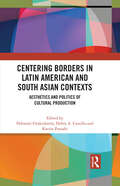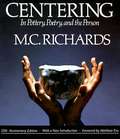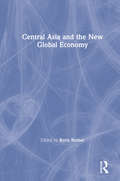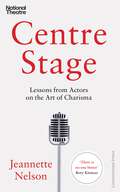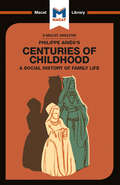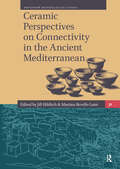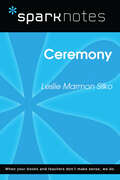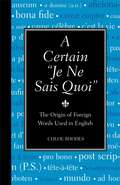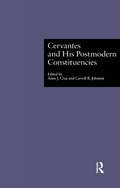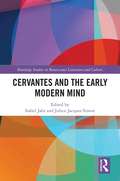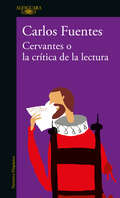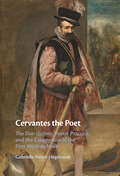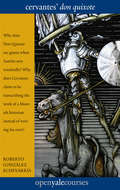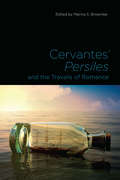- Table View
- List View
Censored: A Literary History of Subversion and Control
by Matthew Fellion Katherine InglisA provocative history of literary censorship uncovers the limits of free speech in the United Kingdom and the United States.
Censorship and Conflict in Seventeenth-Century England: The Subtle Art of Division (Penn State Series in the History of the Book)
by Randy RobertsonCensorship profoundly affected early modern writing. Censorship and Conflict in Seventeenth-Century England offers a detailed picture of early modern censorship and investigates the pressures that censorship exerted on seventeenth-century authors, printers, and publishers. In the 1600s, Britain witnessed a civil war, the judicial execution of a king, the restoration of his son, and an unremitting struggle among crown, parliament, and people for sovereignty and the right to define “liberty and property.” This battle, sometimes subtle, sometimes bloody, entailed a struggle for the control of language and representation. Robertson offers a richly detailed study of this “censorship contest” and of the craft that writers employed to outflank the licensers. He argues that for most parties, victory, not diplomacy or consensus, was the ultimate goal. This book differs from most recent works in analyzing both the mechanics of early modern censorship and the poetics that the licensing system produced—the forms and pressures of self-censorship. Among the issues that Robertson addresses in this book are the workings of the licensing machinery, the designs of art and obliquity under a regime of censorship, and the involutions of authorship attendant on anonymity.
Censorship and Conflict in Seventeenth-Century England: The Subtle Art of Division (Penn State Series in the History of the Book)
by Randy RobertsonCensorship profoundly affected early modern writing. Censorship and Conflict in Seventeenth-Century England offers a detailed picture of early modern censorship and investigates the pressures that censorship exerted on seventeenth-century authors, printers, and publishers. In the 1600s, Britain witnessed a civil war, the judicial execution of a king, the restoration of his son, and an unremitting struggle among crown, parliament, and people for sovereignty and the right to define “liberty and property.” This battle, sometimes subtle, sometimes bloody, entailed a struggle for the control of language and representation. Robertson offers a richly detailed study of this “censorship contest” and of the craft that writers employed to outflank the licensers. He argues that for most parties, victory, not diplomacy or consensus, was the ultimate goal. This book differs from most recent works in analyzing both the mechanics of early modern censorship and the poetics that the licensing system produced—the forms and pressures of self-censorship. Among the issues that Robertson addresses in this book are the workings of the licensing machinery, the designs of art and obliquity under a regime of censorship, and the involutions of authorship attendant on anonymity.
Censorship and Ideology: The Translation of Children's Literature in Post-Civil War Spain (Palgrave Studies in Languages at War)
by Julia Lin ThompsonThis book offers a fascinating picture of how state censorship affected children’s literature translation in post-Civil War Spain. Focusing on the Spanish translations of Mark Twain’s children’s classics The Adventures of Tom Sawyer and The Adventures of Huckleberry Finn, the author traces the evolution of the censorship system of the Francoist regime and its impact on Spanish children’s literature during the years after the Spanish Civil War. Drawing on the regime’s censorship laws, official censors’ records, and textbooks, she not only examines the censorship imposed on the translations of Twain’s works, but also offers insights into the intricate connections between state censorship and the regime’s educational aims. The book gives a revealing analysis of the ways in which the highly bureaucratic censorship apparatus operated under Franco’s dictatorship, outlining the flaws and fallacies within it, as well as the strategies adopted by publishers and translators to resist the power of the state. While centred on Francoist Spain, the book also explores broader themes of ideology, censorship, and translation, making it a valuable source for scholars of translation studies and Hispanic studies, as well as those with a wider interest in literature, history, and cultural studies.
Censorship in Vietnam: Brave New World
by Thomas A. BassWhat does censorship do to a culture? How do censors justify their work? What are the mechanisms by which censorship -- and self-censorship -- alter people's sense of time and memory, truth and reality? Thomas Bass faced these questions when The Spy Who Loved Us, his account of the famous Time magazine journalist and double agent Pham Xuan An, was published in a Vietnamese edition. When the book finally appeared in 2014, after five years of negotiations with Vietnamese censors, more than four hundred passages had been altered or cut from the text.After the book was published, Bass flew to Vietnam to meet his censors, at least the half dozen who would speak with him. In Censorship in Vietnam, he describes these meetings and examines how censorship works, both in Vietnam and elsewhere in the world. An exemplary piece of investigative reporting, Censorship in Vietnam opens a window into the country today and shows us the precarious nature of intellectual freedom in a world governed by suppression.
Censorship of Literature in Post-War Poland: In Light of the Confidential Bulletins for Censors from 1945 to 1956
by Anna Wiśniewska-GrabarczykCensorship of Literature in Post-War Poland in the Light of Confidential Bulletins for Censors from 1945 to 1956, reconstructs and presents ways to censor literature (and, contextually, other fields of art) submitted for evaluation to the main censorship office in Poland during the first 11 years after WWII. The source material consists of confidential Bulletins – periodicals addressed to the officials of the censorship office.The book is divided into three main parts, each preceded by an introduction and concluded with an extensive bibliography.Part One: In Search of a Definition: What Were the Confidential Bulletins for Censors? Characteristics of the Source Material presents basic information about the Bulletins – their goals, structure, and material presented in them. The analysis concludes with the definition of confidential Bulletins of the censorship office.Part Two: Literature and Current Literary Phenomena Preconstructs the image of literary life presented in the Bulletins from 1945 to 1956. On numerous occasions, the Bulletins provided helpful guidelines in censorship practice. They discussed the job of dealing with literary texts and often gave examples of works published just a few months earlier or those that had not passed the scrutiny. The Bulletins published materials discussing literary phenomena and other issues. The ones previously unaccounted for (including film, radio and theatre), as well as the institutional background of control, I discuss briefly in the last part – Camera Censorica. What Else was Discussed in the Bulletins?.The materials presented in these confidential periodicals came from the Bulletins headquarters, field offices, and the work of censors. At the end of my study, Author let the censors speak. In the chapter Before the Proper Summary, or… the Censor as an Artist: The Literary Work of the Functionaries of Mysia Street and Its Environs, Author cite evidence of the literary ambitions of political functionaries – as censors had been called in the 1950s.
Centaur Art: The Future of Art in the Age of Generative AI
by Remo PareschiGenerative AI is transforming the landscape of numerous industries, and the creative fields are no exception. As the figurative arts become a focal point in the ongoing debate, this book explores hybrid and centauric intelligence—an integration of human and artificial intelligence. Through parallel and complementary directions, it investigates the general concept of this hybrid intelligence and its specific application in the artistic realm, highlighting the unprecedented creativity and innovation that can emerge from this synergy. Additionally, it addresses the economic tensions and legal disputes, particularly around copyright, that arise from the impact of new technologies in the creative sector. The result is a comprehensive overview of the hybridization paradigm by analyzing the operational and creative methods of artists and creators who have embraced generative AI. The author examines the implications of the recent developments, offering readers an understanding of how AI can support human creativity rather than replace it. Thus, a compelling vision of the future unfolds, one in which artists and AI collaborate, pushing the boundaries of what is artistically achievable. Whether you are a seasoned professional looking to incorporate AI into your creative process or a curious reader intrigued by the convergence of art and technology, the book will provide valuable insights and inspire you to explore the fascinating intersection of human creativity and artificial intelligence and the future it heralds for the art world.
Centaurs And Amazons: Women And The Pre-history Of The Great Chain Of Being (Women And Culture)
by Page DuBoisIn Centaurs and Amazons, Page duBois offers a prehistory of hierarchy. Using structural anthropology, symbolic analysis, and recent literary theory, she demonstrates a shift in Greek thought from the fifth to the fourth century B.C. that had a profound influence upon subsequent Western culture and politics. Through an analysis of mythology, drama, sculpture, architecture, and Greek vase painting, duBois documents the transition from a system of thought that organized the experience of difference in terms of polarity and analogy to one based upon a relatively rigid hierarchical scheme. This was the beginning of "the great chain of being," the philosophical construct that all life was organized in minute gradations of superiority and inferiority. This scheme, in various guises, has continued to influence philosophical and political thought. The author's intelligent and discriminating use of scholarship from various fields makes Centaurs and Amazons an impressive interdisciplinary study of interest to classicists, feminist scholars, historians, art historians, anthropologists, and political scientists.
Center Stage 1: Express Yourself in English
by Irene Frankel Maryann Florez Sharon SeymourCenter Stage 1: Express Yourself in English , by Irene Frankel (Series Consultants: MaryAnn Florez and Sharon Seymour), gives your students the communicative skills to start using English effectively in their daily lives. Center Stage 1 is an integrated four-skills course that supports student learning and achievement. Practical language and timely topics motivate beginning students to master grammar along with speaking, listening, reading, and writing skills.
Center Will Hold: Critical Perspectives On Writing Center Scholarship
by Michael PembertonIn The Center Will Hold, Pemberton and Kinkead have compiled a major volume of essays on the signal issues of scholarship that have established the writing center field and that the field must successfully address in the coming decade. The new century opens with new institutional, demographic, and financial challenges, and writing centers, in order to hold and extend their contribution to research, teaching, and service, must continuously engage those challenges. Appropriately, the editors offer the work of Muriel Harris as a key pivot point in the emergence of writing centers as sites of pedagogy and research. The volume develops themes that Harris first brought to the field, and contributors here offer explicit recognition of the role that Harris has played in the development of writing center theory and practice. But they also use her work as a springboard from which to provide reflective, descriptive, and predictive looks at the field.
Centering Borders in Latin American and South Asian Contexts: Aesthetics and Politics of Cultural Production
by Debaroti ChakrabortyThis book presents inter-disciplinary research on contemporary borders with contributions from scholars and cultural practitioners located in different contexts in the Americas and South Asia. There has been significant sociological work on borders; however there is a relative dearth of humanities research on contemporary border realities, particularly in South Asia. This volume introduces frameworks of critical insights and knowledge on border narratives and cultural productions. It addresses and goes beyond the impact of the partition in South Asia to train a unique comparative and aesthetic lens on borders and borderlands in relation to Latin America and the U.S.A. through oral narratives, photographs, ‘objects’, films, theatre, journals, and songs. It maps border perspectives and their reception in a framework of cultural politics. It revolves around themes such as violence and modes of survival; women’s narratives of migration, trafficking and incarceration; abduction of children; vulnerability as experience; rationalities of mass killings; and proliferation of countercultures to map border perspectives in a framework of cultural politics. First of its kind, the volume will be useful to scholars and researchers of comparative literary and cultural studies, South Asian studies, Latin American studies, border studies, arts and aesthetics, visual studies, sociology, comparative politics, international relations, and peace and conflict resolution studies.
Centering in Pottery, Poetry, and the Person (2nd edition)
by Mary Caroline RichardsA discussion of how to balance life through use of pottery, poetry and education. The book uses examples of the author's poetry.
Central Asia and the New Global Economy: Critical Problems, Critical Choices
by Boris Z. RumerCentral Asia's new states have been buffeted by financial ill winds from East Asia and Russia and by Islamic revolutionary movements from the south. In the context of widespread and deepening impoverishment, endemic corruption, gaping inequalities, and external pressures to undertake difficult reforms, economic crisis threatens to expand into profoundly destabilizing social and political crises as well.This volume analyzes the geopolitical and macroeconomic situation of Central Asia, local policy responses to the current crisis, and alternative scenarios for the foreseeable future. It devotes particular attention to Kazakhstan, Turkmenistan, and Uzbekistan. Beyond the immediate case, the book focuses on policy measures and institutional improvements that could most directly impact the capacity of economies in the region to adapt to the globalization process.
Centre Stage: Lessons from Actors on the Art of Charisma
by Jeannette NelsonHow the world’s best actors communicate with gravitas – and how you can, too.‘The theatre stars’ voice guru’ Daily MailActing is all about charisma. Whether you’re an A-list star or an extra, when you’re on stage you need to perform in a way that makes your audience listen.That stage presence is something we can all learn from. Every time you speak up in a meeting, recount an anecdote, or tell a joke, it’s essential to communicate with gravitas.Jeannette Nelson knows a thing or two about gravitas. As Head of Voice at the National Theatre, she has spent three decades working with the world’s leading actors – from Al Pacino to Benedict Cumberbatch to Juliette Binoche – teaching them to speak clearly and move confidently.Now, Nelson pulls back the curtain on the tricks that professional performers use to own the room. Starting with clear speech and good posture, before moving on to the art of rhetoric and overcoming stage fright, she outlines a holistic three-stage method to communicating with authority, authenticity and eloquence. Throughout, she peppers the book with stories of how world-renowned actors learnt to make themselves heard – and how you can, too.The result is a fascinating and eminently practical guide to the art of performance. If all the world’s a stage, then this book will turn you into its lead actor.
Centuries of Childhood (The Macat Library)
by Joseph Tendler Eva-Marie PragIn Centuries of Childhood, the French historian Philippe Aries offers a fundamentally fresh interpretation of what childhood is and what the institution means for society at large. Aries's core idea is that ‘childhood,’ as we understand it today – a special time that requires special efforts and resources – is an invention of the 19th century, and that before that date children were in effect thought of as small adults. This led him to a re-evaluation of sources that suggested a second, crucial, conclusion: the idea that these competing visions of childhood were the products of two very different conceptions of human society. <P><P>An earlier, essentially communal, social ideal, Aries wrote, had been supplanted by a society far more family-centric and hence inward-facing. In his view, moreover, this increased focus on childhood posed a direct challenge to a well-entrenched social order. ‘One is tempted to conclude,’ he wrote, ‘that sociability and the concept of the family were incompatible, and could develop only at each other's expense.’ <P><P>This revolutionary thesis, which has inspired and infuriated other historians in roughly equal measure, was made possible by Aries's determination to understand the meaning of the evidence available to him and highlight problems of definition that others had simply glossed over, making Centuries of Childhood an important example of the critical thinking skill of interpretation.
Ceramic Perspectives on Connectivity in the Ancient Mediterranean (Amsterdam Archaeological Studies)
by J. Hilditch M. Revello LamiThe identification of ceramic imports within prehistoric and historic assemblages has long been the primary indicator for identifying connections between different sites and regions. Yet this has fostered a presence/absence diagnosis for contact between different communities. Approaches such as post-colonial perspectives and network analysis, which focus on the nature of the connections, are now beginning to offer more meaningful ways of considering past interactions. These approaches can bridge the traditional divide between prehistoric and historic and offer a valuable contribution to the wider study of past interactions in the ancient Mediterranean., The geographical or topographical setting of an archaeological site is often acknowledged as an important factor in their significance or how well connected the community was within the cultural landscape. But to what extent do geographical categories such as island, coast, mainland or hinterland influence modern ideas on the dynamics of these ancient communities? This volume uses ceramic studies across multiple spatial and diachronic scales to provide new insights into the connectivity of ancient Mediterranean communities.
Ceremony (SparkNotes Literature Guide Series)
by SparkNotesCeremony (SparkNotes Literature Guide) by Leslie Marmon Silko Making the reading experience fun! Created by Harvard students for students everywhere, SparkNotes is a new breed of study guide: smarter, better, faster.Geared to what today's students need to know, SparkNotes provides:chapter-by-chapter analysis explanations of key themes, motifs, and symbols a review quiz and essay topicsLively and accessible, these guides are perfect for late-night studying and writing papers.
Certain "Je Ne Sais Quoi", A
by Chloe Rhodes"English doesn't borrow from other languages. English follows other languages down dark alleys, knocks them over, and goes through their pockets for loose grammar." -James D. Nicoll Organized alphabetically for easy reference, A Certain "Je Ne Sais Quoi" is an accessible lexicon of foreign words and phrases used in English, containing everything from aficionado (Spanish) to zeitgeist (German). Inside you'll find translations, definitions, origins, and a descriptive timeline of each item's evolution. Entries include: À la carte: from the card or of the menu (French) Fiasco: complete failure (Italian) Dungarees: thick cotton cloth/overalls (Hindi) Diaspora: dispersion (Greek) Smorgasbord: bread and butter (Swedish) Cognoscenti: those who know (Italian) Compos mentis: having mastery of one's mind; with it (Latin) Attractively packaged with black and white illustrations, this whimsical yet authoritative book is a great gift for any etymologically fascinated individual. Use this book to reacquaint yourself with the English language, and you'll be compos mentis in no time.
Cervantes and His Postmodern Constituencies (Hispanic Issues #Vol. 17)
by Anne J. Cruz Carroll B. JohnsonThe essays in this collection represent the first effort in Hispanism to address the conflicted status of Cervantes studies by interrogating the possibility of continued critical dialogue in the context of postmodern theories that threaten to divide into oppositional discourses. Comprising broad historical overviews as well as close readings of texts, and wielding the rhetoric of scientific detachment and of impassioned political commitments, the essays at once exemplify and critique multiple critical positions. The collection takes a meaningful and timely look at the formation of cervantismo from the early twentieth century to the prevailing debates on postmodernism and the current crisis of literary studies.
Cervantes and the Early Modern Mind (Routledge Studies in Renaissance Literature and Culture)
by Isabel Jaén Julien Jacques SimonThis book explores the work of Cervantes in relation to the ideas about the mind that circulated in early modern Europe and were propelled by thinkers such as Juan Luis Vives, Juan Huarte de San Juan, Oliva Sabuco, Andrés Laguna, Andrés Velásquez, Marsilio Ficino, and Gómez Pereira. The editors bring together humanists and scientists: literary scholars and doctors whose interdisciplinary research integrates diverse types of sources (philosophical and medical treatises, natural histories, rhetoric manuals, pharmacopoeias, etc.) alongside Cervantes’s works to examine themes and areas including emotion, human development, animal vs. human consciousness, pathologies of the mind, and mind-altering substances. Their chapters trace the cognitive themes and points of inquiry that Cervantes shares with other early modern thinkers, showing how he both echoes and contributes to early modern views of the mind.
Cervantes o la crítica de la lectura
by Carlos Fuentes«Don Quijote, el loco, está loco no sólo porque ha creído lo que ha leído. También está loco porque cree, como caballero andante, que la justicia es su deber y que la justicia es posible.» Desde Zona sagrada hasta Terra Nostra, la narrativa de CarlosFuentes oscilaba entre la sobriedad en el relato y la obra como una broma que asaltaba la realidad para trastocarla. En su discurso de ingreso en El Colegio Nacional hizo ver la similitud de obras totalizantes, como Don Quijote de la Mancha de Miguel de Cervantes y Finnegans Wake de James Joyce.Discurso que se extiende, retrocede y avanza en estos ensayos que incitan a revisar y releer estas y otras obras que rompen la realidad e inventan una nueva, alterna y paralela, pero llena de rebelión, que resaltan sus características y nos hacen ver el mundo con otros ojos; por ejemplo, el Quijote desde antes de ser escrito, revisado en su época y a lo largo de su existencia, en su España árabe y judía y ya contaminada del Nuevo Mundo, con sus personajes reales y ficticios que salen de otros libros y asaltan otras literaturas. Una incitación a la lectura rebelde, y a rebelarse, con una fantasía que es mejor y más vital que cualquier realidad posible.
Cervantes the Poet: The Don Quijote, Poetic Practice, and the Conception of the First Modern Novel
by Gabrielle Ponce-HegenauerCervantes the Poet travels from the court of Isabel de Valois to Rome, Naples, Palermo, Algiers, and Madrid's barrio de las letras. Recovering Cervantes' nearly forty-year literary career before the publication of Don Quijote, Gabrielle Ponce-Hegenauer demonstrates the cultural, literary, and theoretical significance of Cervantes' status as a late-sixteenth-century itinerant poet. This study recovers the generative literary milieus and cultural practices of Spain's most famous novelist in order to posit a new theory of the modern novel as an organic transformation of lyric practices native to the late-sixteenth century and Cervantes' own literary outlook.
Cervantes' "Don Quixote"
by Roberto González EchevarríaThe novel Don Quixote, written in the late sixteenth and early seventeenth century by Miguel de Cervantes Saavedra, is widely considered to be one of the greatest fictional works in the entire canon of Western literature. At once farcical and deeply philosophical, Cervantes’ novel and its characters have become integrated into the cultures of the Western Hemisphere, influencing language and modern thought while inspiring art and artists such as Richard Strauss and Pablo Picasso. Based on Professor Roberto González Echevarría’s popular open course at Yale University, this essential guide to the enduring Spanish classic facilitates a close reading of Don Quixote in the artistic and historical context of renaissance and baroque Spain while exploring why Cervantes’ masterwork is still widely read and relevant today. González Echevarría addresses the novel’s major themes and demonstrates how the story of an aging, deluded would-be knight-errant embodies that most modern of predicaments: the individual’s dissatisfaction with the world in which he lives, and his struggle to make that world mesh with his desires.
Cervantes' Epic Novel
by Michael Armstrong-RocheMiguel de Cervantes conceived his final work, The Labours of Persiles and Sigismunda: A Northern Story (1617), as a great prose epic that would accomplish for its age what Homer and Virgil had done for theirs. And yet, by the eighteenth century Don Quixote had eclipsed Persiles in the favour of readers and writers alike and the later novel is now virtually forgotten except by specialists. This study sets out to help restore Persiles to pride of place within Cervantes's corpus by reading it as the author's summa, as a boldly new kind of prose epic that casts an original light on the major political, religious, social, and literary debates of its era. At the same time it seeks to illuminate how such a lofty and solemn ambition could coexist with Cervantes evident urge to delight. Grounded in the novel's multiple contexts - literature, history and politics, philosophy and theology - and in close reading of the text, Michael Armstrong-Roche aims to reshape our understanding of Persiles within the history of prose fiction and to take part in the ongoing conversation about the relationship between literary and non-literary cultural forms. Ultimately he reveals how Cervantes recast the prose epic, expanding it in new directions to accommodate the great epic themes - politics, love, and religion - to the most urgent concerns of his day.
Cervantes' Persiles and the Travails of Romance (Toronto Iberic)
by Marina S. BrownleeThis collection of original essays presents new ways of looking at Cervantes’ final novel. Persiles, a work that engages with geopolitical models of race, ethnicity, nation, and religion, takes its inspiration from the highly influential Ethiopian Story (the Aithiopika) of Heliodorus. With particular relevance to the period, Persiles questions the issue of cultural pluralism in the Spanish empire and emphasizes the need to rethink the radically altered category of lo bárbaro/the barbarian (which included not only the Jew, the Muslim, and the Gypsy, but also the criollo, the mestizo, and the indiano), a new multiracial and multiethnic reality that posed a profound challenge to early modern Spain. The contributors offer a range of perspectives in spatial theory, psychology and subjectivity, visual culture, and literary theory.
